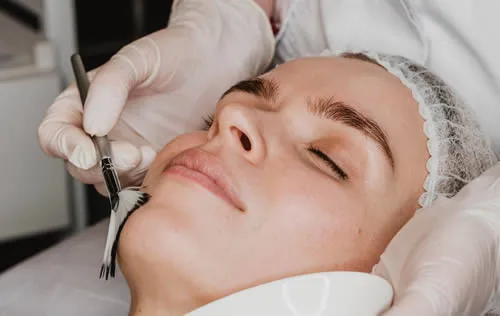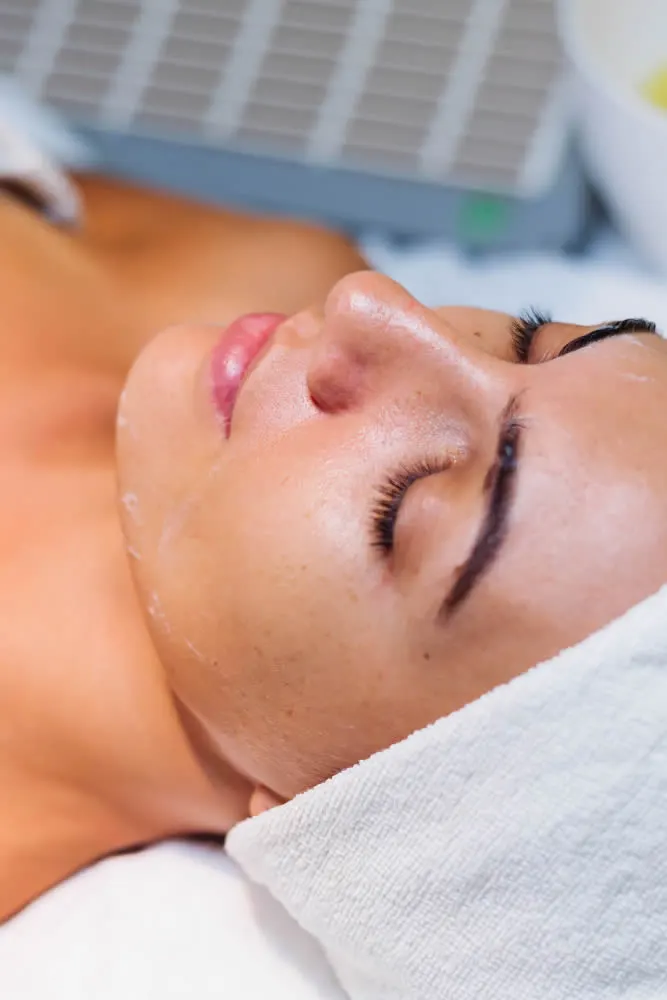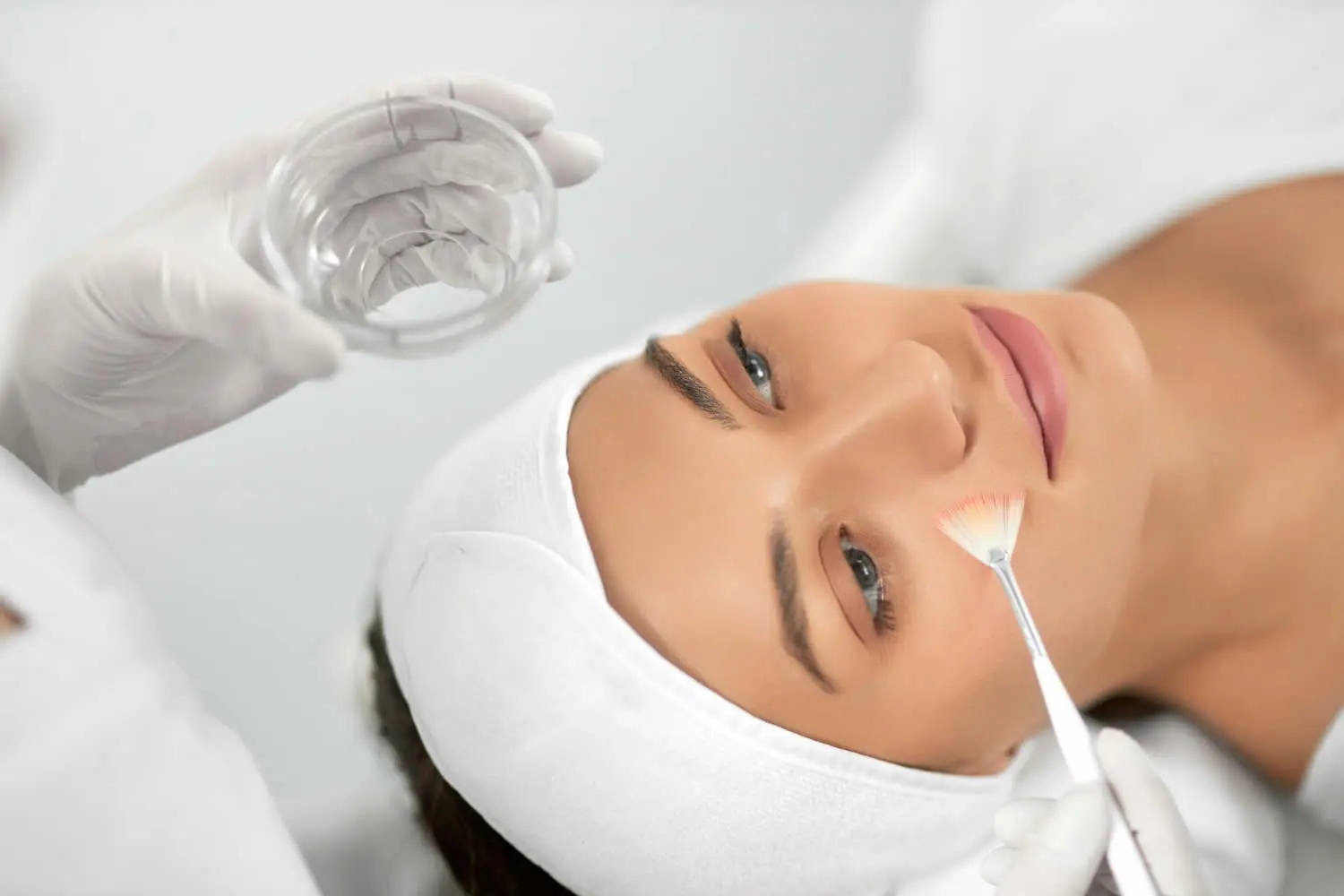What are Chemical Peels?
Chemical peels are a cosmetic procedure in which a chemical solution is applied to the skin to exfoliate the top layer of dead skin cells, resulting in a smoother, more even complexion. Chemical peels are commonly used to improve the appearance of fine lines and wrinkles, age spots, acne scars, and uneven skin tone.
There are several types of chemical peels, each with different strengths and depths of penetration. The most common types of chemical peels are:
- Superficial Peels: These are the mildest form of chemical peel and use a mild acid such as alpha-hydroxy acid (AHA) to exfoliate the top layer of skin. Superficial peels are used to improve the appearance of fine lines, sun damage, and mild acne.
- Medium Peels: These use a stronger acid such as glycolic acid or trichloroacetic acid (TCA) to penetrate deeper into the skin and remove damaged skin cells. Medium peels are used to improve the appearance of fine lines, age spots, and acne scars.
- Deep Peels: These use a very strong acid such as phenol to penetrate deep into the skin and remove damaged skin cells. Deep peels are used to treat severe sun damage, deep wrinkles, and scars.

Benefits of Chemical Peels
- Skin Renewal and Resurfacing:
Chemical peels work by applying a specialized solution to your skin, prompting the exfoliation of dead and damaged outer layers. This process stimulates the growth of fresh, healthy skin cells, resulting in a smoother and more even skin texture. - Improved Skin Tone and Pigmentation:
Uneven skin tone, sunspots, and hyperpigmentation can be visibly reduced with chemical peels. The treatment targets areas of discoloration, revealing a more uniform and radiant complexion. - Minimized Fine Lines and Wrinkles:
Chemical peels can soften the appearance of fine lines and wrinkles, particularly those caused by sun damage and aging. The increased collagen production that follows a peel contributes to a plumper, more youthful skin appearance. - Reduced Acne and Acne Scarring:
For individuals struggling with acne and its aftermath, chemical peels offer significant relief. They unclog pores, reduce inflammation, and can diminish the appearance of acne scars over time. - Pore Size Reduction:
Enlarged pores can be visually minimized through chemical peels, which help cleanse and tighten the pores, resulting in a smoother skin surface. - Enhanced Skincare Product Absorption:
Following a chemical peel, your skin becomes more receptive to topical skincare products. This heightened absorption allows for more effective delivery of beneficial ingredients, maximizing the results of your skincare regimen. - Boosted Confidence and Self-Esteem:
Experiencing the positive changes in your skin can lead to a boost in self-confidence. Achieving a clearer, more youthful complexion often translates to increased self-esteem and a greater sense of well-being. - Quick and Convenient Treatment:
Chemical peels are generally quick procedures that can often be done during a lunch break. They require minimal downtime, making them a convenient option for individuals with busy schedules.
Step-by-Step Process
- Consultation: The process begins with a comprehensive consultation with DrName. During this session, you’ll discuss your skincare concerns, goals, and medical history. This information will help in determining the most suitable type of chemical peel for your skin type.
- Preparation: Before the procedure, DrName will provide you with specific guidelines to follow to ensure optimal results. Depending on the type of chemical peel chosen, you might be advised to adjust your skincare routine, avoid sun exposure, or discontinue certain skincare products.
- Cleansing: On the day of your chemical peel, your skin will be gently cleansed to remove any makeup, oils, or impurities. This ensures that the chemical solution can penetrate effectively.
- Application of Chemical Solution: DrName will apply the carefully selected chemical solution to your skin. The solution may contain specific acids tailored to address your concerns, such as fine lines, uneven texture, or discoloration. The solution works by exfoliating the outer layers of skin, promoting cell turnover, and revealing fresher, more youthful skin underneath.
- Sensation: You might experience a mild tingling or warmth as the solution is applied.
- Monitoring: During the treatment, we’ll closely monitor your skin’s response to the chemical solution. The timing of the solution’s application is adjusted based on your skin’s reaction, ensuring a safe and effective treatment.
- Neutralization and Removal: Once the desired effect is achieved, the chemical solution will be neutralized and gently removed from your skin.
- Post-Treatment Care: We will provide you with detailed post-treatment instructions. These instructions might include guidelines on skincare products to use, avoiding sun exposure, and any potential side effects you might experience.
- Recovery: Depending on the type of chemical peel, you might experience mild redness, peeling, or flaking in the days following the procedure. This is a natural part of the skin’s renewal process and indicates that fresh, rejuvenated skin is emerging.
Risks and Side Effects of Chemical Peels
While chemical peels are generally safe and effective procedures for skin rejuvenation, it’s important to be aware of potential risks and side effects. Understanding these aspects can help you make an informed decision and ensure a smooth experience during and after your chemical peel treatment at PracticeName in CityName.
Potential Risks:
- Skin Sensitivity: After a chemical peel, your skin may become more sensitive to the sun and other environmental factors. It’s crucial to follow post-treatment instructions and diligently apply sun protection to avoid complications.
- Pigment Changes: In some cases, especially with deeper peels, temporary or permanent changes in skin pigmentation might occur. This risk is more common in individuals with darker skin tones.
- Infection: While infections are rare, there is a slight risk of infection if proper post-treatment care is not followed. This risk can be minimized by keeping the treated area clean and avoiding touching it with unclean hands.
Possible Side Effects:
- Redness and Swelling: It’s normal to experience redness and swelling immediately after the procedure. These effects are usually temporary and subside within a few days to a week.
- Peeling and Flaking: Depending on the depth of the peel, your skin may start to peel and flake a few days after treatment. This is a natural part of the healing process and reveals fresher skin underneath.
- Discomfort: Some mild discomfort, akin to a sunburn, can be expected post-treatment. Over-the-counter pain relievers and cool compresses can help alleviate this.
- Scarring: While scarring is rare, there’s a small risk, particularly if you don’t follow proper aftercare instructions or if the treated area is disturbed during the healing process.
Minimizing Risks:
To minimize the risks and side effects associated with chemical peels, it’s crucial to:
- Follow Aftercare Instructions: Adhere to the post-treatment care guidelines provided by DrName and the team at PracticeName. This includes using recommended skin care products and avoiding direct sun exposure.
- Avoid Picking or Scrubbing: Do not pick at peeling skin or attempt to scrub it off prematurely. This can lead to complications and delay the healing process.
- Attend Follow-Up Appointments: Attend any scheduled follow-up appointments with DrName to ensure that your skin is healing properly and to address any concerns.
Recovery and Aftercare Following Your Chemical Peel
As you embark on this transformative journey, it’s essential to understand the recovery process and the aftercare steps that will help you achieve the best possible results.
Immediate Post-Treatment Care:
After your chemical peel, your skin may appear red, slightly swollen, and more sensitive than usual. You might experience a mild burning or tingling sensation, which is normal and temporary. Here’s what you can expect during the initial hours after your treatment:
- Hydration: Keep your skin well-hydrated by applying a gentle, non-comedogenic moisturizer recommended by DrName. Hydration helps soothe the skin and promotes healing.
- Avoid Makeup: It’s best to skip makeup for the rest of the day after your peel. Let your skin breathe and recover naturally.
- Sun Protection: Sun protection is paramount during the healing process. Apply a broad-spectrum sunscreen with at least SPF 30 before stepping outside, even on cloudy days.
Days Following Your Peel:
As the days progress, you’ll notice changes in your skin’s appearance. Here’s how to care for your skin during the initial recovery phase:
- Peeled Skin: Depending on the depth of your peel, you might experience some peeling, flaking, or crusting. Refrain from picking or scrubbing the peeling skin, as this can lead to irritation and potential complications.
- Gentle Cleansing: Use a gentle cleanser recommended by DrName to cleanse your face. Avoid harsh scrubbing or exfoliation for at least a week after your peel.
- Moisturize: Continue moisturizing to maintain skin hydration and comfort. Your skincare professional can recommend the right products to support your healing process.
- Avoid Irritants: Stay away from products containing retinoids, alpha hydroxy acids (AHAs), and other potentially irritating ingredients until advised by DrName.
- Sun Avoidance: Minimize sun exposure during the initial healing period. If you must be outdoors, wear a wide-brimmed hat and sunglasses, and reapply sunscreen every two hours.
Long-Term Aftercare:
Your commitment to aftercare will greatly influence the longevity of your results. Even after your skin has fully healed, these habits will help maintain your revitalized complexion:
- Sun Protection: Incorporate sun protection into your daily routine. UV rays can accelerate skin aging and counteract the benefits of your chemical peel.
- Healthy Lifestyle: A balanced diet, regular exercise, and proper hydration contribute to overall skin health.
- Skincare Routine: DrName can guide you in developing a skincare routine tailored to your skin type and concerns. This may include products with gentle exfoliation and antioxidants.
Results and Expectations
Here’s what you can anticipate in terms of results and outcomes:
Gradual Improvement:
Chemical peels are designed to gradually improve the appearance of your skin over time. While some immediate results might be noticeable after the first treatment, the full benefits become more evident as your skin undergoes its natural renewal process. Depending on the depth and type of peel, multiple sessions might be recommended for optimal results.
Skin Texture and Tone:
One of the primary benefits of chemical peels is their ability to rejuvenate the skin’s texture and tone. With each session, you can expect a smoother and more even complexion, as the peel works to remove dead skin cells, unclog pores, and stimulate collagen production. This can lead to a radiant and youthful appearance.
Addressing Specific Concerns:
Chemical peels can effectively address a range of skin concerns, including fine lines, wrinkles, acne scars, sun damage, and uneven pigmentation. We’ll assess your skin during the consultation and recommend the appropriate type of peel to target your specific issues.
Multiple Sessions for Optimal Results:
While you might notice some improvement after a single treatment, most patients achieve their desired results through a series of chemical peel sessions. DrName will work closely with you to create a treatment plan that outlines the recommended number of sessions, the frequency of treatments, and the expected timeline for seeing significant improvements.
Downtime and Recovery:
The extent of downtime and recovery can vary based on the depth of the peel. Superficial peels typically involve minimal downtime, with some redness and peeling that can be easily managed with proper post-treatment care. Deeper peels might require more downtime, but the transformative results can make it worthwhile. DrName will provide detailed aftercare instructions to ensure a smooth recovery process.
Long-Term Benefits:
While the immediate results of a chemical peel are rewarding, the long-term benefits are equally valuable. By promoting collagen production and enhancing your skin’s health, you can enjoy a more youthful and radiant complexion that lasts beyond the treatment period.

FAQ About Chemical Peels
What are the different types of Chemical Peel, and which one is right for me?
There are three types of chemical peels: superficial, medium, and deep. The type of peel that is right for you will depend on your skin type, concerns, and desired results. Your dermatologist or healthcare provider can recommend the best type of peel for your needs.
Is a Chemical Peel painful, and what can I expect during the procedure?
Most people do not experience significant pain during a Chemical Peel, though they may feel some stinging or burning sensations. The procedure typically takes 30-60 minutes and involves applying the chemical solution to the skin, allowing it to penetrate for a set amount of time, and then neutralizing it with a special solution.
How long does it take to recover from a Chemical Peel, and when can I expect to see results?
Recovery time from a Chemical Peel depends on the type of peel you receive. Superficial peels typically require no downtime, while medium and deep peels may require several days to a week of recovery time. Results from a chemical peel can be seen within a few days to several weeks after the procedure, depending on the depth of the peel.
Are there any special precautions I should take before and after a Chemical Peel?
Before a Chemical Peel, you may be instructed to stop using certain skincare products or medications. After a peel, it is important to follow proper aftercare instructions, including avoiding direct sun exposure and using gentle skincare products.
How often can I get a Chemical Peel, and is it safe to get them regularly?
The frequency of Chemical Peels depends on the type of peel you receive and your skincare goals. Superficial peels can be done more frequently than medium or deep peels. It is generally safe to get regular chemical peels, but it is important to discuss with your healthcare provider to determine the best treatment plan for your needs.
Can a Chemical Peel be combined with other cosmetic procedures, such as Botox or dermal fillers?
Yes, Chemical Peels can be combined with other cosmetic procedures to enhance results. It is important to discuss combining treatments with your healthcare provider to determine the best approach.
Can a Chemical Peel be used to treat specific skin concerns, such as acne or hyperpigmentation?
Yes, Chemical Peels can be used to treat specific skin concerns, such as acne, hyperpigmentation, and fine lines and wrinkles. The type of peel used will depend on the specific concern being addressed.

